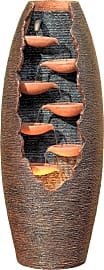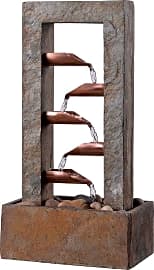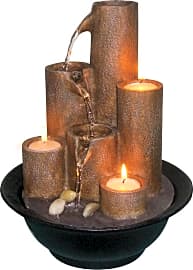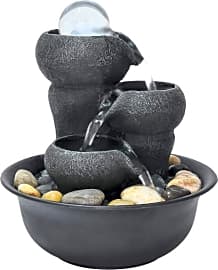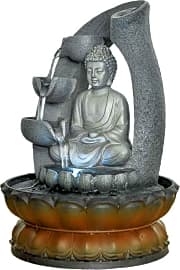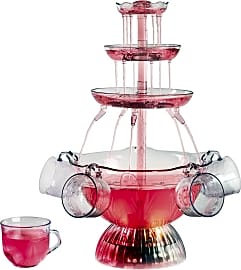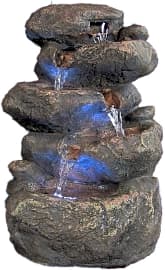The 10 Best Indoor Fountains

This wiki has been updated 42 times since it was first published in June of 2015. Whether you're furnishing a new room or just want to add a touch of elegance and the relaxing sounds of trickling water to your home or workspace, any of these attractive indoor fountains will do the trick. With a variety of designs and both tabletop and freestanding options on offer, this list has something for everyone, whether you prefer modern, whimsical, or classic decor. When users buy our independently chosen editorial choices, we may earn commissions to help fund the Wiki.
Editor's Notes
November 22, 2020:
For this revision, we've added three new models starting with the Chillscreamni Portable Feng Shui, a smaller option that will fit just about anywhere. Another newcomer is the Nostalgia Vintage Party, an out-of-the-box fount with plenty of flair for holiday dinners and gatherings. Both have LEDs to augment the experience. The Kenroy Home Rustic offers the look of natural stone and metal with a cleverly designed flow.
We've also updated the information for several items, including the Alpine Corporation Zen, the Adagio Serene, and the HoMedics Silver Springs. The latter is still our top choice for its stand-out design, affordable price, and good reviews.
The Sunnydaze Decor Aged Tree Trunk has been removed because its reviews just weren't up to par with others on our list, and the John Timberland Ripple is gone because its price had grown too high compared with similar models.
December 18, 2019:
When it comes to indoor fountains, style tends to be the primary consideration, and that makes sense given that many indoor fountains are used to decorate peaceful professional and personal spaces. Here, you'll find options that are perfect for both traditional and contemporary decor, though you'll have to determine what surface your fountain will occupy, as they come in a range of sizes and shapes. If you want to bring more of the outdoors indoors, an artificial plant is a smart solution.
The SereneLife 2-Tier and Deco 79 Metal have been removed due to repeated malfunction complaints. In their place, we’ve added the HoMedics Silver Springs and SunJet Buddha, which occupy the top two spots in the list. The two new models were added because of their popularity and particularly versatile designs.
Special Honors
John Timberland Modern Couple It's an expensive fountain, but that's because it features one of the most sophisticated, romantic designs out there. This one also holds up just fine outside too, which makes it a smart solution for people who feel the urge to redecorate fairly often. lampsplus.com
Melrose International Metal Leaf Fountain This imposing fountain stands at over 60 inches in height. It has a two-gallon water capacity and produces pleasing sounds that are loud enough to carry through larger rooms, and rooms with high ceilings. A great choice for entryways and dining areas, you'll likely want to share its beauty with guests. wayfair.com
Sintechno Lovely Couple This tabletop option with a pair of white doves eschews muted earth tones in favor of bright pinks, oranges, and yellows. If you're looking for a way to add a pop of color to your home office, this piece will definitely do the trick. It comes fully assembled. overstock.com
A Brief History Of Fountains
Since then, fountain construction has slowed considerably, and any new creations are purely for decoration.
The history of mankind has been closely tied to our ability to find fresh drinking water, as we quickly learned that it's quite difficult to establish any form of civilization when you're thirsty all the time. Of course, for early man, this meant setting up shop near a river or stream and never straying too far from it. Eventually, however, we figured out a way to bring the water to us by using fountains.
The first known fountain was discovered in Iraq, in the form of interconnected stone basins that the ancient Assyrians used to divert water from the Comel River. While their contemporaries in Egypt were able to utilize the Nile for drinking and irrigation, the Assyrians had the benefit of a water source on higher ground, allowing them to use gravity to fill their fountains.
In the 6th century B.C.E., the Greeks created a vast system of aqueducts that transported water to their cities via bronze pipes from rural springs and rivers. The Romans, on the other hand, used lead pipes to siphon water from mountain springs. Rome was filled with fountains, with over 600 available to the general public and even more reserved for the wealthy and powerful.
By the Medieval period, fountains became primarily artistic installations. Many monasteries commissioned fountains in areas designed for reflection and rumination, as the sound of the running water was considered soothing.
During the Renaissance, the customs of antiquity became highly valued, and, as such, a focus was placed on recreating fountains in public spaces. These installations were commissioned by various popes and were intended to show off the opulence of the cities in which they were placed, ideally to demonstrate the wealth that accompanied being a faithful follower of Christ, because Jesus was all about chasing that paper.
In the 19th century, many cities in Europe and America experienced population booms, and supplying enough water to their citizens increasingly became a concern. This led to a rise in the construction of aqueducts bringing water from the country to fountains in the city, and the invention of the steam pump enabled citizens to put fountains inside their homes for the first time. This meant that, by the century's end, public fountains were used almost exclusively for decoration.
Since then, fountain construction has slowed considerably, and any new creations are purely for decoration. We no longer get our drinking water from fountains, but they have become increasingly popular in homes and offices as a means to establish a classy and soothing atmosphere.
Why You Need An Indoor Fountain
It's difficult to overstate just how relaxing it can be to have a fountain gently babbling in the background as you go about your day. At a time when stress-related illnesses are on the rise, finding a way to lower your blood pressure is absolutely essential.
The calm, steady sound of the running water can act as white noise, gently drowning out any other sounds that could distract you or interfere with your practice.
If you meditate — and you should — having a fountain nearby can help you focus your attention and redirect your thoughts. The calm, steady sound of the running water can act as white noise, gently drowning out any other sounds that could distract you or interfere with your practice.
Having a fountain isn't just about your health, however — they're also visually appealing. The dynamic nature of the fountain instantly makes it a focal point of any room in which it's placed, giving you an automatic conversation starter.
Many people also consider installing a fountain to be good Feng Shui, as the energy of the water is believed to bring wealth and prosperity. Of course, there aren't any reputable studies to back this up, but if the fountain lowers your stress levels, at the very least it will save you some money on doctor bills.
Finally, the water can help keep your home or office at a comfortable temperature, lowering your utility costs. In addition to cooling the room, they'll also help to humidify, which is excellent for anyone who is prone to respiratory problems.
How To Choose The Right Indoor Fountain
Now that I've sold you on the value of adding a fountain to your home or office, it's time to decide which model is best for you.
The first thing you need to consider is whether you want a free-standing or wall-mounted option. Free-standing models are usually less expensive and can be moved from room to room, while wall-mounted fountains are often more durable and can bolster the resale value of the home. There's no wrong answer here — and no rule that says you can't get both.
Also, keep in mind that if you get a wall-mounted version, you'll need to mount it.
Also, keep in mind that if you get a wall-mounted version, you'll need to mount it. If you don't have the tools or desire to do any light remodeling work, you're probably better off getting a free-standing option.
The size of the fountain is another important consideration. Some of these things are truly massive, which makes a powerful statement to your guests — but also takes up a lot of space. How much of your personal bubble are you willing to share with a fountain?
If possible, you should listen to it before you buy it. Is it too loud for you to concentrate, or too soft for you to hear? There's no point in getting a fountain for its soothing sounds if those noises give you a headache or require you to sit right next to it.
Beyond that, it's all about style. Find one that you'll enjoy looking at, day in and day out, and make sure it meshes with your existing decor (you want it to stand out, but not for the wrong reasons).
Ultimately, though, the most important factor is that it fills your guests with shame over how much classier you are compared to them.


